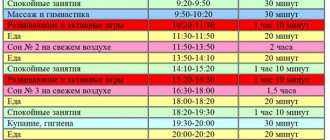What are training contractions?
As you can easily guess from the name, they are not real. These uterine contractions are not aimed at starting the labor process. Usually they are irregular, rare and do not cause significant pain.
This phenomenon has other names. Sometimes they are called even more obviously - false, as opposed to true labor pains. In the specialized literature you can find the term “Braxton-Hicks contractions” after the name of the English obstetrician-gynecologist who first drew attention to them and described them.
How to distinguish false contractions from real ones
How not to confuse Braxton Hicks contractions with the onset of labor and not end up in the hospital ahead of time? Just calm down, then listen carefully to your body and prepare a watch with a timer:
- False contractions do not have a clear rhythm; they pass smoothly, without acute increasing pain. While true ones are repeated with a certain frequency (more than 7 per hour), they become more frequent and increase in strength.
- With practice contractions, you'll be able to sleep through the night. You are unlikely to fall asleep at home with the real ones.
- In false contractions, the uterus does not dilate, or it is minimal and does not change in any way for a long time. The real ones promote full dilatation of the uterus up to 10 cm and lead to a period of pushing.
- True contractions are often accompanied by bleeding, unlike false ones.
- In real contractions, the pain is more pronounced: the stomach and lower back are pulled, the entire uterus is tense, and it “bursts” unpleasantly.
- Even if false contractions are “painful,” they can be stopped. Sometimes a simple change of position, proper rest, or a relaxing massage helps.
If contractions mark the beginning of labor, it is impossible to stop them, except to slightly relieve the pain. And you can learn exactly how to do this in the courses of our online school “Easy Childbirth”.
How can you understand that everything that is happening to you is no longer a “rehearsal”, but the real beginning of labor? If you are 38 or 40 weeks pregnant, pain increases rapidly, and the interval between them decreases. There are also more obvious signs. If suddenly there is a rupture of amniotic fluid, go to the emergency department of the selected maternity hospital. During the examination, the doctor will check the degree of maturity of the cervix and its length. On CTG, it will be possible to observe the contractile activity of the uterus, the nature of contractions and the fetal heart rate. The results of the study will show whether labor has definitely begun, what method of birth will be required, and whether the baby in the womb is suffering from a lack of oxygen.
Why do they happen?
Medicine does not have an exact answer to this question. There is not even a consensus on whether they are part of the normal pregnancy process or a deviation from it. Most experts adhere to the first version, considering them to be a warm-up for the body before real childbirth.
It is assumed that false contractions are needed to maintain the tone of the uterus - it, like any other muscular organ, requires periodic exercise. On the other hand, the time of arrival and frequency of training contractions vary greatly among different women, and some mothers who have successfully given birth are not at all familiar with these sensations.
strong false contractions
I sit and think - where should I start my story? 9 months have already passed, I remember everything as if it were yesterday, but for 9 months I have had a completely different life.....)))
My last post on BB was written within the walls of the hospital, during the prenatal hospitalization..... then I wrote, read - and was worried that I was going through the transition, that it was time to give birth, but my cervix was still not ready. And how I wanted to give birth on Sunday, August 21st! Because according to the zodiac sign it is also Leo (like me), the sum of 21 is 3 (as for me - August 3), because on August 22 another large taxiway is closed for washing and ours should have had a strong influx of women in labor, because on Tomorrow they gave me a 1.5-liter bottle to collect urine, because at 38.6 it’s already time and it’s possible))) The PDR was on August 29, and I didn’t want to move at all! And then the doctors tell me - my cervix is not ready, lie down and enjoy))) pffffff)))))
Saturday. August 20. 20-30. My heavily pregnant brain hangs out on the Internet, reading stories about childbirth from girls with PCOS, after ginipral, how to stimulate yourself for childbirth, etc.))) The other eye looks on TV at Sultan Suleiman with his harem, scrolling through the feed, I try to quietly twist my nipples ( where is that smiley face with the monkey covering its eyes?), then my back starts to hurt. I didn’t immediately understand that the pain was strange: sometimes it hurts, sometimes it doesn’t...... Without finishing yet another story about childbirth, I typed the next query - about contractions. Okay, I think. I'll go to bed and take a nap. I remember my sister’s phrase: “you can’t sleep through childbirth.”
I woke up in the first hour of the night already from severe back pain (namely in the back, my stomach didn’t hurt at all), I started counting...... the intervals were completely different - from 10 minutes to 3, then 7 minutes in a row, then again 3 minutes . I already have the feeling that these are false contractions, or maybe not contractions at all……. All the medical staff on the floor are already asleep, it’s a pity to wake them up (where is that smiley again?)…. then I decide to go into the nurse’s room. I wake up the nurse with the words “I think I’m having contractions,” she sends me to count the intervals with the words “when it’s 2 minutes, come.” Gone. Sitting. Lie. I think. Lying down, meanwhile, is already becoming painful. As well as standing. Walk. Dance. Time hour. intervals from 30 seconds to two minutes. I go to the nurse, who calls the doctor. Examination on the chair. The cervix is closed, stiff, the verdict is false contractions, prescription: papaverine in the butt and sleep. OK. After the injection, the contractions did not stop, they did not become easier to bear, the time did not increase, and the pain increased.
4 a.m. I wake up the nurse and say that it’s becoming more and more difficult to endure, and can you look at me again? Doctor on the operation, wait. 5-30 am - examination on a chair, the cervix is closed, stiff, verdict - contractions are false, prescription: papaverine in the butt and sleep, re-examination after 2 hours. By the way, I was alone in the room, which is very good - I didn’t wake anyone up. But it’s bad - I ran out of water on Friday... the heat is +40, and the boiled water from the tap made me sick. I drank boiled water one sip at a time, and slowly went crazy..... walked back and forth along the corridor, the ward..... then to one window. then to another. The pain becomes unbearable to endure, and I begin to moan....moan as if someone is satisfying me well)))))))))
At 8:30 the doctor comes and takes a look. The cervix is closed, stiff, the verdict is false contractions, prescription: papaverine in the butt and sleep, re-examination after 2 hours. And then Ostap suffered))))) I’m screaming from your papaverine, it’s neither cold nor hot, I can’t stand this pain anymore! The doctor goes into the treatment room, comes out with a quarter of the pill and says - here, drink it and go to bed, you will need your strength. I have a drink…….I lie down…..and then HE comes. The same STAR. When the time between contractions is 30 seconds, during which I did not have time to move away from the previous one...... when you want to climb the wall, but you are not Spider-Man yet..... Somehow I endured an HOUR!!! I ran out into the corridor at 9:30 shouting “Cesarean me, give me a painkiller, do at least something - I can’t take it anymore” - and then the nurses ran in and called the doctor))) examination on the chair: dilatation of 4 fingers, the treasured flow began to flow some water! after it flowed out - the dilation was already 5 fingers, the doctor commanded “To the labor room” - and I exhaled! Eat. Not false. This means I’m definitely going to give birth, and I’ll be suffering with contractions for another day. Like a baggage with a diaper between my legs, I got to the room, a nurse helped me pack my things. They took me down to the enema room, where from the window I even saw my brother, who came to give me a package (the long-awaited water). Our dialogue was very productive: - Kostya! - Oh, hi! - Go, go! (at that moment another contraction hit me))))) Immediately after the enema, in the shower, I felt a pushing. It’s the efforts – and not the consequences of the enema. I was taken to the 3rd floor, to a private delivery room. The time was around 11. They connected the CTG. And I started pushing. One.....two....three...... - to no avail. Again…..and again……and again……..the doctor and midwife tell me that I’m pushing incorrectly, I’m trying to do as they say…..but I just don’t have the strength anymore…….the contractions are too painful and there’s no water , sleep - I was simply exhausted. I pushed long and hard......on my head. The baby was squeezed out, I myself just couldn’t give birth ((((I can imagine how tired she was during this process. Yes, I was breathing incorrectly. I tried to breathe the way I was taught in the courses. I tried to breathe like that during contractions too. What's the point? If I go to give birth a second time, then again I won’t understand how to breathe (well, where is that smiley face). Therefore...... I already agreed to everything. C-section, vacuum, forceps, squeezing...... But it turned out to be squeezing.
13-10. After another (probably the twentieth) squeezing out, my daughter was born. August 21. My lion. My Miroslava. My dream came true. My little blue bundle was placed on my chest. SOKB named after Seredavin, Samara. Doctor - Violetta Vladimirovna Vyazovkina.
Literally 2 days later I already forgot that I was pregnant and once walked with a belly. As if it wasn’t happening to me))) To say that I immediately forgot about the pain I suffered is to plunge into the world with rose-colored glasses)))) NO! I still remember this pain. And the emotions from the birth of a child did not overcome the shock of the pain suffered - I was simply not ready for such pain. But this is my body. For some, giving birth is not painful, and contractions last an hour. It was different for me. Everything is individual. And at the birth table, I wasn’t worried about myself. I was worried about her. But one thing I know for sure is that it’s worth it. So I’m writing this story, and during this time a little fluffy man has already crawled around me, and stood, pulled my leg, and fell asleep, and woke up, and hugged in his arms))))) this is a miracle, I already wrote about it in 37 weeks - and I will always write)).
What week do training contractions begin?
They can begin already in the middle of pregnancy - from the 20th week, in rare cases even earlier. 2-3 weeks before the planned date, their frequency often increases. In this period they are called precursor, emphasizing that there is not long left before childbirth. However, even in the later stages, training contractions do not cause dilatation of the cervix and continue to remain only the body’s preparation for the main event.
The beginning of training contractions by week of pregnancy.
Indicators of pregnancy pathology
In some cases, pain in the lower abdomen may be a sign of problems in the healthy course of pregnancy. They require immediate medical attention.
1. Temperature. An increase in body temperature against the background of painful muscle contractions of the uterus may indicate the development of an intrauterine infection. In this case, inflammation of the membranes or placenta occurs. When diagnosed, the pregnant woman also has polyhydramnios, and the fetus has tachycardia. The inflammatory process is a dangerous complication. According to statistics, 90% of cases of late miscarriages and premature births are associated with infectious diseases. Therefore, if the body temperature rises, a woman should consult a doctor as soon as possible.
2. Severe pain. Training contractions are not characterized by significant pain, and if the pain is intense, this may indicate placental abruption even in the absence of bleeding. With central detachment, a hematoma can form in the woman’s body, between the wall of the uterus and the placenta. This condition threatens the life of the mother and child, and therefore requires immediate hospitalization of the pregnant woman.
3. Frequent occurrence. If false contractions occur more often than four times per hour and more than six times during the day, this may be a sign of premature labor. Only timely medical assistance can stop them, so you need to see a doctor as soon as possible.
If these conditions are detected, you should call your doctor and tell them how you feel. The doctor will recommend further tactics of action. If you can’t get through to the doctor, you need to call an ambulance or go to the maternity hospital yourself.
pixabay.com/
How long do training contractions last?
Contractions last several seconds, rarely up to 1 minute, and end as suddenly as they come. Then the expectant mother begins to listen to her feelings and wait for new ones, but they do not repeat themselves. When the woman has completely calmed down, contractions may return after a considerable time - 4-5 hours.
After several unexpected cases, false contractions become familiar, and the expectant mother ceases to be afraid of them. However, in the last weeks until hour X, they may surprise you again - often training contractions before childbirth become longer and more intense.
Fact No. 7
Many people fear that, having gotten used to training contractions, they simply won’t understand when it comes to action.
Do not worry! It is difficult to confuse precursor contractions (even if they are quite strong) with real ones. But you shouldn’t relax either. After all, training contractions may well turn into prenatal contractions. Therefore, even if false or precursor contractions have become commonplace and familiar to you, still listen to your body, pay attention to the frequency, duration and regularity of contractions.
How do you feel during training contractions?
False contractions are not painful, but, unfortunately, if this is your first pregnancy, you have nothing to compare with. But there is another sure sign: all the muscles of the uterus are involved in labor contractions, and during training pain sensations are localized only in one area.
Frequency and localization of training contractions of the second and early third trimester, precursor contractions, labor contractions. Example.
False contractions usually appear as muscle spasms in the back, front, or top of the uterus. The intervals between them are irregular, and it is impossible to predict where the attack will move next time. A few weeks before giving birth, training contractions, which are now called precursor contractions, will become more frequent, but will retain their character - an attack localized in one area of the uterus. During labor contractions, all the muscles of the uterus contract simultaneously.
Voronezh Regional Clinical Hospital No. 1
As you know, the birth of a baby is preceded by labor pains. Contractions are contractions of the walls of the uterus - a natural physiological process.
It is not uncommon for the uterus to contract during pregnancy, but many women do not notice this. And those who are preparing to become mothers for the first time, on the contrary, perceive these contractions as a danger to the course of pregnancy and the unborn child. Therefore, it is very important that every pregnant woman is given information about training contractions at the earliest stages. Women who have undergone theoretical training are more attentive to their health and observe the changes that occur. They can recognize when they are experiencing training contractions and know how to respond.
Training contractions (or false contractions) are contractions of the uterine walls that do not lead to dilatation of the cervix. They are a preparatory stage for the female body for future childbirth. False contractions are very important for labor, as they help smooth and soften the cervix and prepare it for the upcoming birth. The duration of muscle tension can be about 2 minutes. And their frequency of occurrence is up to several times per hour. False contractions do not increase in frequency or intensity. The period of occurrence occurs in the second and third trimester.
The main symptoms of training contractions:
- A feeling of tightness and aching pain in the groin area and lower abdomen.
- Irregularity and irregularity of contractions.
- They appear only in one area of the abdomen.
- Contractions can occur up to 6 times per hour.
- False contractions do not radiate to the back, as happens with real contractions.
- Does not cause severe pain. Inattentive women may not even notice such contractions.
- They gradually disappear. After a short amount of time, the uterus calms down and becomes soft.
Reasons for the occurrence of training contractions:
- excessive activity, physical activity;
- mobile actions of the developing fetus
- psycho-emotional stress, worries and worries about future birth;
- Bladder fullness;
- Having sex during pregnancy.
In most cases, a woman can independently avoid training contractions of the uterus. Pregnant women need to drink the required amount of water, not be nervous and remain calm until the birth. It is not recommended to induce training contractions on your own, because... The body is individual, and if false contractions do not appear, then there is no need for training for the body.
But if symptoms appear, they must be used to train breathing exercises. Proper breathing will help relieve a pregnant woman's condition during labor.
Several techniques for proper breathing:
- After the contraction ends, take a deep breath, and during the contraction, exhale slowly.
- Take slow, deep breaths through your nose, then exhale short, sharply through your mouth.
- Take frequent, shallow breaths during the next contraction. However, due to the low oxygen supply, this method can lead to dizziness.
What to do if you start having training contractions?
- Turn on relaxing music, calm down and tune in to positive thoughts.
- Take a comfortable position
- Go for an easy, leisurely walk
- Drink enough water;
- Do breathing exercises
- Take a warm shower;
Alarm Signals
There are symptoms that require medical attention. To exclude and prevent the development of dangerous pathologies, if you experience minor discomfort in the lower abdomen, you should consult a doctor.
In what cases should you urgently consult a doctor:
- severe pain in the back and lower abdomen;
- bloody, mucous, or watery discharge;
- decreased fetal activity;
- increased frequency of spasms
- bleeding
With normal intensity of training contractions, there is no need to worry, because the body itself is preparing for the upcoming happy event - the birth of your baby!
Alyokhina S.V. - head nurse of the Perinatal Center
Bulgakova O.V. — senior midwife of the Department of Pregnancy Pathology No. 3
Are training contractions dangerous?
There is no evidence that training contractions have any effect on fetal development. Their only danger is psychological. Some women, feeling unexpected contractions of the uterus, panic, and in this state they can do stupid things.
Remember that the onset of any contractions, even labor, does not mean that you will give birth in the next few minutes. There is time, so you need to calm down, take a deep breath and listen to your feelings. If you can't tell whether these are practice contractions or real contractions, call your doctor and describe your symptoms. After listening to your answers, he will tell you what to do - go to the maternity hospital or stay at home.
How to distinguish training contractions from contractions before childbirth?
Expectant mothers can almost accurately identify training contractions during their second and subsequent pregnancies. While you do not have experience yet, we recommend paying attention to the following signs:
- Training contractions are rarely painful, rather unexpected. The same cannot be said about childbirth - many women compare these sensations with very severe pain during menstruation.
- Training contractions can usually be stopped. Leisurely walking around the room, breathing exercises and other calming exercises can completely eliminate discomfort in the uterine area.
- They are not regular and have no obvious dynamics. In real contractions, on the contrary, there is regularity, a gradual increase in duration and a decrease in the interval between them.
For simplicity, we have collected the distinguishing features of false and true contractions in a table:
Is it possible to calculate training contractions somehow easier?
It just won't work. You will still have to listen to your feelings and record them. But you can get yourself an assistant - a special mobile application for calculating the duration and intervals between contractions. All such applications work intuitively - you just need to press a large button every time an attack begins or ends.
Mumlife contraction counter.
In addition to recording and visualizing contractions, the application has useful additional functions. It tracks the dynamics of the seizures and will tell you if it is similar to labor. And it will even show how much time you have left to get to the maternity hospital.
What to do?
You don’t have to do anything - after a while, the training contractions will go away on their own. However, there are several proven methods that help reduce discomfort during false contractions and make them disappear quickly. Here are some of them:
- Walk around the house.
Calm, slow walking in most cases allows you to get rid of unexpected uterine contractions. If the weather is good outside and there is a suitable place for exercise nearby, you can also take a breath of fresh air - this will not be a bad thing.
- Lie down and relax.
If you're not in the mood for a walk right now, lie down on the sofa or bed, find a comfortable position and think about something positive. It has been noticed that the best results are obtained by lying on your left side.
- Take a bath or shower.
Water relaxes, and during training contractions this is just what you need. Fill the bathtub with water or stand in the shower and wait for the contractions to end there - most likely, this will happen very soon. But remember: only warm water, no hot baths or contrast showers!
- Drink some water.
Dehydration can cause muscle spasms, so it is also considered a factor in causing false contractions. Pour a glass of water and drink it slowly, alternating sips, inhalations and exhalations. Water can be replaced with some other drink, but only healthy, for example, berry juice or rosehip decoction.
- Do breathing exercises.
Proper breathing techniques are useful not only during training contractions. Before childbirth, they help to calm down, during childbirth - to relieve pain and better control your body. While the body is training the uterus, you train your breathing.
- Go to the toilet.
A full bladder is considered one of the culprits of false contractions: it puts pressure on the uterus, provoking its contractions. So before you settle into bed or go for a walk, don't forget to visit the toilet.
- Walk around the house.
Calm, slow walking in most cases allows you to get rid of unexpected uterine contractions. If the weather is good outside and there is a suitable place for exercise nearby, you can also take a breath of fresh air - this will not be a bad thing.
- Go to the toilet.
A full bladder is considered one of the culprits of false contractions: it puts pressure on the uterus, provoking its contractions. So before you settle into bed or go for a walk, don't forget to visit the toilet.











